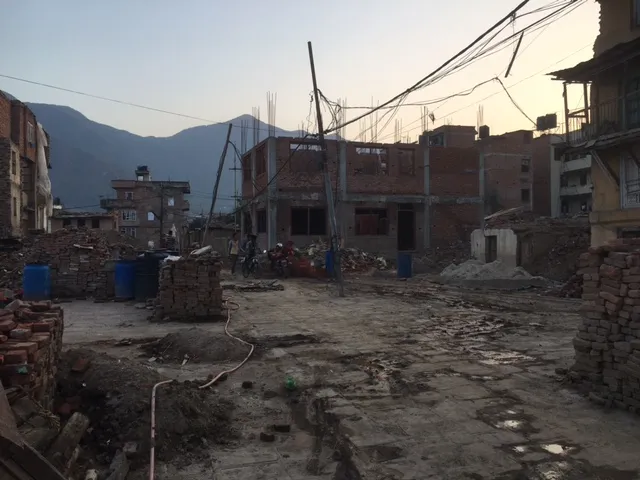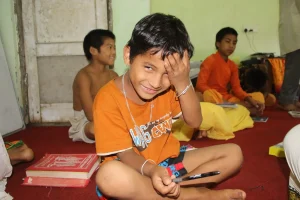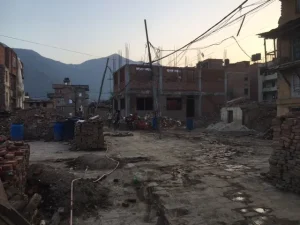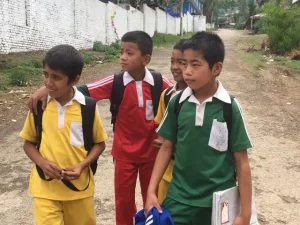Entering Gorakh Nath Secondary School in Kirtipur, Nepal on Wednesday, we were greeted by administrators and teachers who placed cloths around our necks and welcomed us into the school. We made introductions and discussed the school’s needs and how Reinstalling Hope could help. As we stepped out into the courtyard, we were immediately swarmed by droves of excited students who, for what they lacked in inhibition, more than made up for with curiosity, energy, and charisma. They did not know our purpose for being there, but appreciated our presence nonetheless. Students both young and old were quick to brandish newly-learned English phrases — “How are you?” “What is your name?” “Where is your mother?” The younger students jumped around us, wondering who we were, asking from where we came or what our favorite games were. The reception was, undoubtedly, surreal. This was just the first meeting of a (hopefully) long and fruitful relationship between Gorakh Nath and Reinstalling Hope, but the excitement and energy made it seem as though we had already impacted the students’ lives simply by being there. Frankly, it felt great.
“Great” was a natural, understandable response. As I think back to the visit, though, I have trouble with this feeling. In the moment, both our team and the students were genuinely excited and having fun in each other’s presence. However, life does not exist in tangential moments of vivid emotion. Rather, life exists in the everyday reality of one’s world. When we left Gorakh Nath, we debriefed the day’s work at a restaurant which served Nepal’s famous momo dumplings. We went home and took showers. The students, on the other hand, faced a completely different reality. The large majority of them are orphans — they attend school during the day, then work as laborers in the community to earn food and a place to sleep at night. They exist in in extreme poverty, and even those who excel in school and the SLC exam will likely never afford their final two years before University (in Nepal, these two years are called the +2 phase).
I am bothered that my upbringing in Palo Alto, California is the only valid explanation for why I can aspire to be a physician-writer, while Gorakh Nath students work tirelessly for a future that, as it stands now, will never come. Their teachers call them curious, inquisitive, and honest. The students love dancing, social studies, and chemistry. They work hard and take nothing for granted, even though the large majority of them will be forced to drop out after tenth grade. I spoke with one student who had enrolled in school after running away from home in the fourth grade. His family (living in rural Nepal) wanted him to work on the farm or in a factory and would not support his education, so he jumped on a bus to Kathmandu and begged the Gorakh Nath headmaster to allow him into the school.
As I consider these sights, sounds, and stories, I see schools like Gorakh Nath as a sort of microcosm for Nepal as a whole. The country is beautifully unique — an intriguing blend of cultures, ethnicities, and beliefs. It is also wrecked by natural disaster, filled with government corruption, and currently faced with more problems than solutions. All the while. Nepal’s people are gracious, hospitable, and appreciative for everything they have. It is thus apparent that Nepal is challenged with building a functional public education system, while at the same time rebuilding a beautiful, yet troubled nation. The former challenge will require empowerment of Nepal’s impoverished students through financial support, better school resources, and pedagogical interventions. The latter will need better infrastructure and homes for those displaced by the earthquake, and a coherent and effective government response — even in the face of protests over Nepal’s new constitution.
While we at Reinstalling Hope provided support following the earthquake in 2015, our role in this process is unarguably on the side of education. The question we face is how to improve a public education system bogged down by deep socioeconomic disparities, caste discrimination, and lack of effective resources and pedagogical approaches. How do you convince professional teachers to consider and apply new, outside methods of instruction? How do you motivate a student who could never dream of affording a +2 education, or who skips class to work on a farm in order to eat at night? How do you define a school’s most urgent needs when their answer to the question is “everything?”
We do not have a clear solution. What we do know is that such questions are best approached in the context of holistic, school-wide interventions. At Reinstalling Hope, we work closely with individual schools, looking from the perspective of each major component: The teachers, their students, and the school’s resources. More importantly, we formulate our interventions through conversations with the schools and their communities, who know better than anyone what they need in order to improve. Whether we provide scholarships, supplemental classes, teaching workshops, a small library, or any combination of approaches depends largely on these conversations. We first build relationships and trust, so that together with these schools we may build a better education and future for Nepali students.

Upon leaving Gorakh Nath for the first time, we promised the students that we would return the next day. They were excited and relieved, maybe even surprised that these new visitors were so eager to come back to their marginalized community. Our organization will continue returning to Gorakh Nath and two other schools with which we are forming relationships, because building a better education system is not a summer project. Rather, it will take time, thought, and effort to enable these students to reach their full potentials — to exist beyond extreme poverty. But like the country in which they live, the potential is high, and the people are unwavering and genuine. They will move forward. It is up to us to empower Nepal to build, and rebuild.





